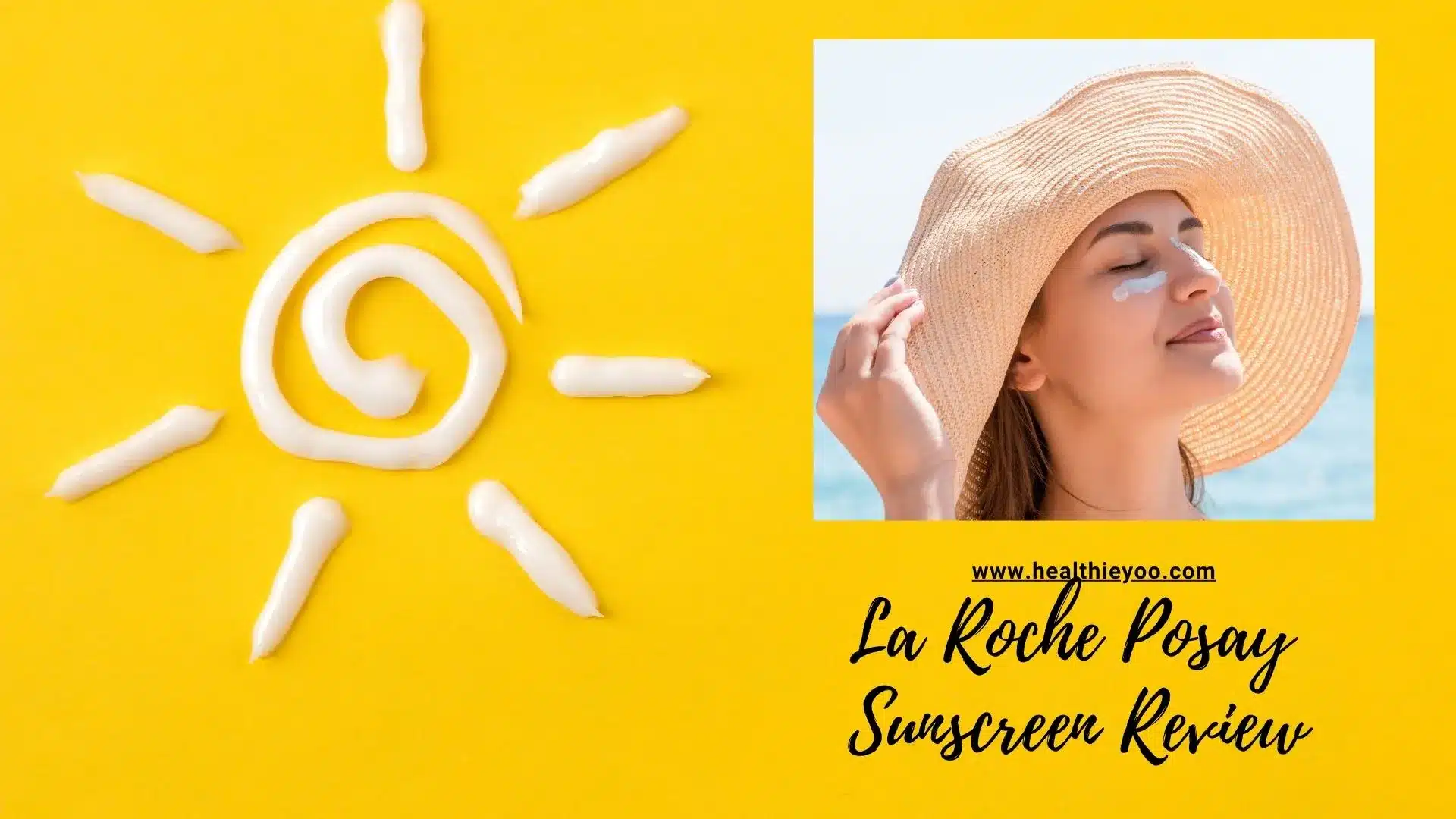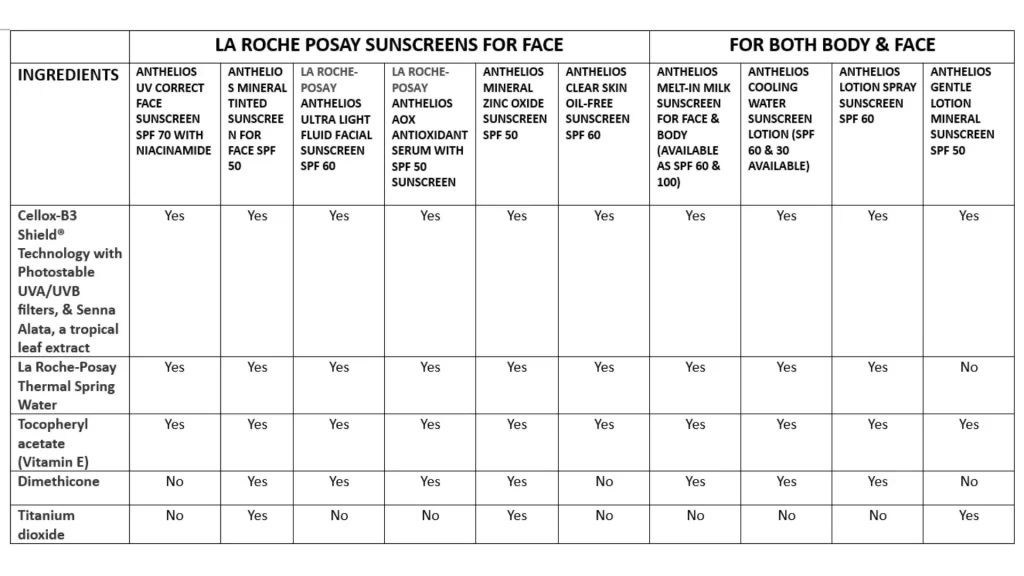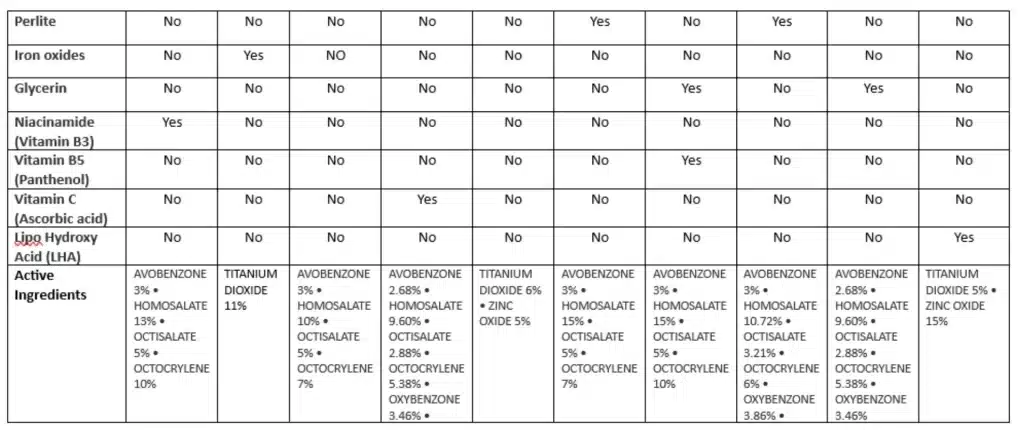Here is your guide to selecting the La Roche Posay Sunscreen Anthelios range for sun protection and added benefits too! So, which one to choose – Go through the Anthelios UV Correct Face Sunscreen with Niacinamide Or La Roche Posay Mineral Tinted Sunscreen Review, Or La Roche Posay Melt-in-Milk Sunscreen, face vs body sunscreen, kids sunscreen, ultra-light, spray sunscreen, or sunscreen for sensitive skin review, and more? The Cellox-B3 Shield technology coupled with UVA/UVB protection and antioxidants with antiaging potential for your health and beauty needs.
UV Radiation and Health Risks
It is widely known that excess exposure to ultraviolet radiation (UVR) is associated with several serious health issues such as skin damage, skin photoaging (atrophy, pigmentary changes, and wrinkles), solar sunburn, skin sensitization, immunosuppression, and malignancy (1).
There are three types of UV radiation: UVA, UVB, and UVC. The ozone layer absorbs 100% of UVC radiations, hence sunscreens do not need to protect against that. The ozone layer absorbs 90% of UVB and minimal UVA. Therefore, ozone layer depletion increases the risk of UV transmission (2). UVA radiation is divided into UVA I (340 to 400 nm) and UVA II (320 to 340nm). Both UVA and UVB radiation have deleterious effects. UVA mainly promotes photoaging and pigmentation by penetrating the inner layer of skin, called the dermis, where it releases free radicals and causes oxidative damage. UVB, however, can penetrate only the outer layer, called the epidermis, but is responsible for several deleterious skin effects, including nonmelanoma skin cancers.
The benefit of daily sunscreen usage has been demonstrated and proven through several research studies. Sunscreens can be physical or chemical, with physical barriers that reflect and scatter light, and chemical barriers that absorb light. Chemical or organic sunscreen’s mechanism of action is based on its chemical structure (aromatic compound conjugated with a carbonyl group) which allows high-energy UV rays to be absorbed. Chemical sunscreens consist of both UVA and UVB-blocking properties. UVB filters absorb the entire spectrum of UVB radiation (290 to 320 nm). UVA filters do not cover the entire spectrum of UVA radiation. Broad-spectrum sunscreens absorb UV radiation from both the UVA and UVB portions (2).
While we know that UV radiation is the most common cause of sun damage, there can be damage through visible light too. Visible light can induce erythema in light-skinned individuals and pigmentation in dark-skinned individuals. Broad-spectrum sunscreens protect against UVA and UVB radiation but do not protect against visible light. Minerals such as zinc oxide and titanium dioxide are used in the form of nanoparticles in sunscreens to minimize the chalky and white appearance of the skin, but they do not protect against visible light. Tinted sunscreens use iron oxides and pigmentary titanium dioxide in different concentrations to provide protection against visible light (3).
When it comes to sun protection, La Roche-Posay is a brand that comes to our minds instantly. In recent years, there has been so much hype about La Roche Posay’s cutting-edge skincare technologies offering a wide range of sunscreens shielding our skin from harmful UV rays and providing various additional benefits. In this blog post, we will explore the world of La Roche-Posay sunscreens to uncover the reasons why they are trusted by skincare enthusiasts worldwide. At the same time, we will also look at the ingredients and other features of the range of sunscreens La Roche Posay offers to provide you with a comparative view to help you decide which one is best for you.
We have previously provided you with a general guide to sunscreens, the types of sunscreens, the benefits of applying sunscreens, how to apply sunscreen, how to select the right sun protection factor (SPF), and more (4). Here we provide you specifically the La Roche Posay Sunscreen Review to help you select the right sunscreen for your skin. So, check out in the table below of comparison of ingredients in some popular La Roche Posay sunscreens for face and body, for kids, and the varieties to choose from, including La Roche Posay melt-in-milk sunscreen, ultra-light, spray, UV correct, and more.
Types of La Roche Posay Sunscreens
We have broadly categorized Anthelios La Roche Posay Sunscreens according to the body part you can apply to. Hence, La Roche Posay Anthelios sunscreens can be categorized into face sunscreen and body sunscreens:
Face vs Body Sunscreens
La Roche Posay face and body sunscreens are designed to protect different areas of the skin, and while they share similarities, there are some key differences between the two.
The first one is that the sunscreens designed for the face have gentler ingredients so that they do not cause any irritation to the delicate skin. Such sunscreens are usually lighter in texture and are less likely to clog pores on the face (non-comedogenic). On the other hand, body sunscreens are intended to cover a large part of the skin, therefore, have a thicker consistency.
Face sunscreens often come in smaller packaging and have a cosmetically elegant finish, blending well with makeup. On the other hand, body sunscreens usually come in larger bottles and are designed for application on larger areas like arms, legs, and torso.
Another difference that is typically seen, irrespective of the brand, is that while both face and body sunscreens contain similar active ingredients like avobenzone, octinoxate, or zinc oxide, face sunscreens may have additional ingredients that cater to specific facial needs. For example, they might include antioxidants like vitamin C or green tea extract to combat free radicals and protect against environmental damage.
Further, body sunscreens are often formulated to be more water-resistant and sweat-resistant as compared to face sunscreens. It’s important to note, however, that while face and body sunscreens are formulated differently, you can still use a body sunscreen on your face, if needed. But, if you have specific concerns, such as sensitive or acne-prone skin, it might be beneficial to choose a sunscreen specifically formulated for the face to minimize the risk of irritation or breakouts.
With the above background, La Roche Posay offers different types of face sunscreens and body sunscreens as given below. This includes La Roche Posay Tinted Sunscreens, Melt-in-Milk, Ultra-light, Clear skin, Cooling water, Spray, and Kids sunscreens.
La Roche Posay Face Sunscreens
- Anthelios UV Correct Face Sunscreen SPF70 with Niacinamide
- La Roche Posay Anthelios Mineral Tinted Sunscreen for Face SPF50
- Anthelios Ultra-Light Fluid Facial Sunscreen SPF 60
- Anthelios AOX Antioxidant Serum with SPF 50 sunscreen
- Anthelios Mineral Zinc Oxide Sunscreen SPF 50
- Anthelios Clear Skin Oil-free Sunscreen SPF 60
La Roche Posay Sunscreens For Both Face and Body
- Anthelios La Roche Posay melt-in-milk sunscreen for the face & body
- Anthelios SPF 60 Face & Body Sunscreen Set
- Anthelios Cooling Water Sunscreen Lotion SPF 60
- Anthelios Cooling Water Sunscreen Lotion SPF 30
- Anthelios SPF 50 Gentle Lotion Mineral Sunscreen
- Anthelios Lotion Spray Sunscreen SPF 60
La Roche Posay Kids Sunscreen
- Anthelios La Roche Posay Gentle Lotion Kids Sunscreen SPF 50
Anthelios La Roche Posay Sunscreen Ingredients Review
1. Cellox-B3 Shield Technology
La Roche-Posay’s proprietary Cellox-B3 Shield Technology applies to all its sunscreens. This technology combines UVA/UVB broad-spectrum sun protection along with the antioxidant Senna alata leaf extract. The antioxidant effect of the plant extract is claimed to protect against the skin-damaging free radicals caused by the sun (5).
Senna alata, also known as Cassia alata, candle bush, craw-craw plant, Acapulco, ringworm bush, or ringworm plant, is commonly found in Asia and Africa. Historically, the plant has been used in Ayurveda for the treatment of wounds and skin infections in addition to multiple other uses. It possesses antibacterial, antifungal, and antioxidant properties (6).
2. La Roche-Posay Thermal SpringWater
This special water is the key ingredient in most of the La Roche Posay Face and Body Sunscreens. This water is sourced from a town in France named La Roche Posay. The water is a unique combination of minerals, trace elements, and a high concentration of selenium (5). Selenium is an antioxidant that possesses an antiaging and anti-inflammatory potential (7).
3. Tocopheryl Acetate (Vitamin E)
Tocopherol or Vitamin E is well-known for its potent antioxidant and photoprotection properties. Tocopheryl acetate is a synthetic, more stable form of vitamin E which has less probability of getting oxidized. Additionally, it can penetrate the skin layer where it neutralizes oxidative free radicals (1). Tocopheryl acetate is present in La Roche Posay melt-in-milk sunscreen and all the Anthelios La Roche Posay Face and Body Sunscreens because of these properties.
4. Dimethicone
Dimethicone is a silicone-based polymer commonly used in skincare and cosmetic products. It is primarily used as an emollient and skin conditioning agent. It forms a protective barrier on the skin’s surface, helping to prevent moisture loss and keeping the skin hydrated. The protective barrier can also help shield the skin from environmental irritants and pollutants. It is non-comedogenic, unlikely to clog pores, and hence used in a wide range of skincare products, including those designed for oily or acne-prone skin.
It is commonly used in sunscreens mainly to improve their spreadability and enhance their water-resistant property. It has been added to most of the La Roche Posay Anthelios face and body sunscreens as indicated in the table below including melt-in-milk sunscreen, La Roche Posay mineral tinted sunscreen, and ultra light sunscreen, etc.
5. Titanium dioxide and Zinc Oxide - La Roche Posay Tinted Sunscreen Ingredient Review
These are physical sunscreens. There are two inorganic filters (also known as mineral filters) to physically block UV radiation and are approved by the USFDA – titanium dioxide (TiO2) and zinc oxide (ZnO). These molecules absorb, reflect, and refract UV light but function mainly by absorbing UV radiation. Earlier, the formulations of mineral sunscreens often left a white, chalky appearance on the skin, but now nanoparticles, size <100nm, of TiO2 and ZnO minimize this. ZnO has broad protection against both UVA and UVB, while TiO2 provides better protection against UVB. La Roche Posay tinted sunscreen review showed that it has both types of sunscreens available.
Organic ultraviolet (UV) filters such as oxybenzone and octinoxate recently became controversial due to their potential risk to the environment as well as human health risks. However, the human health risks and risk to the environment is extremely low with inorganic filters. But human health risks may be there if they are inhaled through spray (8).
We performed La Roche Posay Anthelios mineral tinted sunscreen review for the face and body and found that the sunscreen contains titanium dioxide with iron oxide while Anthelios mineral zinc oxide sunscreen for face contains both titanium dioxide and zinc oxide. Anthelios La Roche Posay gentle lotion mineral sunscreen for both the face and body also contains both minerals. All have an SPF of 50. Overall, the review revealed that the human, as well as the environmental risk with La Roche Posay tinted sunscreen or mineral sunscreen, is lower compared to chemical sunscreens (9).
6. Silica
Silica is basically a mineral and is used in sunscreens for its photostability property and other benefits. Silica can help enhance the photostability of sunscreen formulations. UV filters can degrade or become less effective when exposed to sunlight, but silica can aid in stabilizing these ingredients and preventing their degradation, thereby maintaining the sunscreen’s efficacy over time. Silica particles can also contribute to the sunscreen’s UV protection by scattering and reflecting UV radiation.
While the primary UV protection in sunscreens comes from active ingredients (chemical or mineral UV filters), silica particles can assist in improving the overall sun protection performance by reducing the penetration of UV rays into the skin. Silica used in sunscreens is typically in the form of microfine particles. These particles are transparent and do not leave a visible white cast on the skin. This is especially important in sunscreens intended for daily use. It also has oil-absorbing properties. Due to the several useful features of Silica, it has been added to several of the La Roche Posay Sunscreens of the Anthelios range such as La Roche Posay Melt-in-milk sunscreen, tinted, ultra light, etc., as provided in the below mentioned table.
7. Vitamin C
Vitamin C or Ascorbic acid is a potent and well-known antioxidant. Its photoprotective actions against both UVA and UVB radiations have been well established. Topical ascorbic acid was also experimentally shown to reduce the incidence of skin tumors in mice after chronic exposure to UVR. In addition to photoprotection, it has been shown to reduce erythema, sunburn cell formation, and immunosuppression (1). La Roche Posay Anthelios AOX antioxidant serum contains ascorbic acid.
8. Vitamin B5 (Panthenol)
Vitamin B5, also known as Panthenol, is known for its moisturising and hydrating actions. Panthenol is also believed to support the skin’s barrier function. It helps strengthen the outermost layer of the skin, known as the stratum corneum, which acts as a protective barrier against external irritants. Panthenol is a water-soluble ingredient and is compatible with various sunscreen formulations, including both chemical and mineral sunscreens. It can be incorporated into different sunscreen products, such as lotions, creams, gels, or sprays. The La Roche Posay Melt-in-Milk Sunscreen for the face and body contains Vitamin B5 or Panthenol.
9. Niacinamide
Niacinamide, also called nicotinamide, is the active form of vitamin B3. It is a water-soluble vitamin. Several clinical studies have proven that topical niacinamide can protect against photoaging in Asian and Caucasian women. Further, studies have demonstrated the effects of niacinamide against UV-induced immunosuppression, and melanosome transfer, resulting in its anti-photoaging and anti-hyperpigmentation effects (1). Additionally, it has antioxidant and anti-inflammatory properties. Due to these benefits, the La Roche Posay Anthelios UV Correct Face Sunscreen contains Niacinamide.
10. Glycerin
Glycerin is a common ingredient found in many skincare products, including sunscreens. It is a natural compound that belongs to the category of humectants. It is known for its moisturizing properties. It is a humectant, which means it attracts water from the environment and helps to retain moisture in the skin. In sunscreens, glycerin can help hydrate and moisturize the skin, counteracting the potential drying effects of sun exposure and the ingredients in sunscreens.
Glycerin has a viscous and smooth texture, which can aid in the spreadability and application of sunscreen products. It is non-comedogenic meaning it is less likely to clog pores or cause acne breakouts. This property makes it suitable for use in sunscreens, especially for individuals with oily or acne-prone skin. Glycerin is compatible with various sunscreen formulations, including both chemical and mineral sunscreens. It has been added in La Roche Posay Melt-in-Milk and gentle lotion mineral sunscreen for both face and body.
11. Avobenzone 3% • Homosalate 13% • Octisalate 5% • Octocrylene 10% Oxybenzone
The combination of avobenzone, homosalate, octisalate, octocrylene, and oxybenzone represents a sunscreen formulation that utilizes multiple UV filters to provide broad-spectrum protection. The specific percentages mentioned indicate their relative concentrations within the sunscreen formulation.
Avobenzone (3%)
Avobenzone is an organic compound that absorbs UVA radiation. It provides protection against the long wavelength UVA rays, which are associated with premature aging and skin damage. Avobenzone is commonly used in sunscreens as a key UVA filter.
Homosalate (13%)
Homosalate is an organic UV filter that primarily absorbs UVB rays. It helps protect the skin from sunburn and is often used in combination with other UV filters to provide broad-spectrum protection.
Octisalate (5%)
Octisalate, also known as ethylhexyl salicylate, is an organic UVB filter. It absorbs UVB rays and helps prevent sunburn. Octisalate is commonly used in sunscreens due to its stability and compatibility with other UV filters.
Octocrylene (10%)
Octocrylene is an organic UV filter that provides protection against both UVA and UVB rays. It helps enhance the sunscreen’s photostability by reducing the degradation of other UV filters. Octocrylene is often used in combination with other UV filters to boost their effectiveness.
Oxybenzone
Oxybenzone is another organic UV filter that primarily absorbs UVA rays. It helps protect the skin from UVA-induced damage. However, it’s worth noting that there have been concerns about potential environmental and health effects associated with oxybenzone, such as coral reef damage and hormone disruption. Some regions have implemented restrictions or bans on oxybenzone in sunscreens due to these concerns.
Together, these UV filters provide a combination of UVA and UVB protection, ensuring broad-spectrum coverage.
Comparative Profile of Anthelios La Roche Posay Face and Body Sunscreens – Ingredients & Other Features
Benefits of La Roche Posay Anthelios Face and Body Sunscreens
1. La Roche Posay Sunscreens have a tailored Solutions for Different Skin Types
La Roche-Posay understands that every individual has unique skincare needs. Hence, sunscreens are available for sensitive, oily, dry, or acne-prone skin. Our review suggested that various formulations are available, including lightweight fluids, mineral sunscreens or La Roche Posay tinted sunscreen options, clear skin options, and more, and one can find the perfect match for their skin type.
2. La Roche Posay Sunscreens have Broad-Spectrum Protection and Anti-Aging Benefits
Not only do La Roche-Posay sunscreens shield your skin from both UVA and UVB rays, but many of their formulations also offer additional benefits. Hence, the anti-aging properties of some sunscreens, which include antioxidants, can help combat premature aging, reduce fine lines and wrinkles, and improve the overall skin texture.
3. La Roche Posay Sunscreens have a wide range of SPF
Technically speaking, Sun Protection Factor or SPF is a measure of how much solar energy or UV radiation is required to produce sunburn in the presence of sunscreen relative to the amount required to produce sunburn on unprotected skin (10). Increased SPF value indicates higher protection. Those who are fair-skinned absorb more solar energy. If you see the SPF in La Roche Posay face sunscreen or body sunscreen, there is a wide range of SPF including 30, 50, 60, 70, and even 100 in some.
4. La Roche Posay Sunscreen Available for Kids & Gentle Sensitive Skin
Anthelios La Roche Posay sunscreen is specially formulated for kids’ faces and bodies. It is gentle on children’s sensitive skin. It is oxybenzone-free, water resistant, blends easily, and also brushes easily from the skin. Furthermore, the sunscreen is both pediatrician and dermatologist tested, allergy-tested, is paraben free.
The Takeaways
La Roche-Posay face and body sunscreens offer more than just sun protection. With their scientifically backed formulas, tailored solutions for different skin types, exclusive Cell-Ox Shiels technology, broad spectrum UVA/UVB protection, and added skincare benefits including antioxidants, they have become a staple in the beauty industry. By choosing Anthelios La Roche-Posay sunscreens, one can confidently enjoy the outdoors while keeping their skin healthy and radiant. It’s important to note that while this combination of UV filters can provide effective sun protection, individual sensitivities or allergies may vary. If you have specific concerns or known sensitivities, it’s advisable to consult with a dermatologist and consider alternative sunscreen options that meet your specific needs.
Sources
- https://www.ncbi.nlm.nih.gov/pmc/articles/PMC9854756/
- https://www.ncbi.nlm.nih.gov/books/NBK537164/
- https://www.jaad.org/article/S0190-9622(20)30694-0/
- https://www.healthieyoo.com/how-to-choose-the-best-sunscreen-for-your-skin/
- https://www.laroche-posay.us/our-products/sun/face-sunscreen
- https://www.ncbi.nlm.nih.gov/pmc/articles/PMC7054808/
- https://pubmed.ncbi.nlm.nih.gov/20977120/
- https://onlinelibrary.wiley.com/doi/10.1111/phpp.12439
- https://pubmed.ncbi.nlm.nih.gov/30444533/
- https://www.fda.gov/about-fda/center-drug-evaluation-and-research-cder/sun-protection-factor-spf
Affiliate Disclosure – Many products or services or content featured on this website are advertising which means we get a commission if purchases are done through links on our website. Further, we disclose that some of the links in the above post may be sales or affiliate links, and we might receive compensation if you click on them to purchase through them. We do not endorse the advertisements or product reviews published on our website.
Related Posts

Skin Microbiome and Bathing – Best Soap for Skin Miicrobiome?
Bathing and Your Skin Microbiome Recently, a debate among Hollywood celebrities emerged on whether people should bathe as little as possible (1). While some

Sun Protection This Summer And Year Round
Here are the strategies for protection from the sun by a board-certified dermatologist Dr. Mara Dacso including selecting a good tinted sunscreen such as Alastin

Physical vs Chemical Sunscreen, SPF 30 vs 50 – How To Choose The Best Sunscreen?
How to choose sunscreen for your skin and enjoy a clear, healthy, and youthful look? What are the types of sunscreens? Physical vs chemical sunscreen,

Healthy Aging Month 2022: You Are The “Driver” Of Your Health And Wellness
Healthy Aging Month 2022! September is designated as Healthy Aging Month! Let us celebrate healthy aging month 2022 and imbibe some real healthy aging

Ketovore – Eat Well So You Can Feel and Look Well!
What is ketovore? What is a carnivore? The carb addiction teacher explains the difference between ketovore and carnivore and why it is important to be

Yoga & Aging – Yoga Transformation for Healthy Aging!
Aging is a complex biological process that involves a wide range of cellular and molecular changes in an organism over time. It has also been seen



